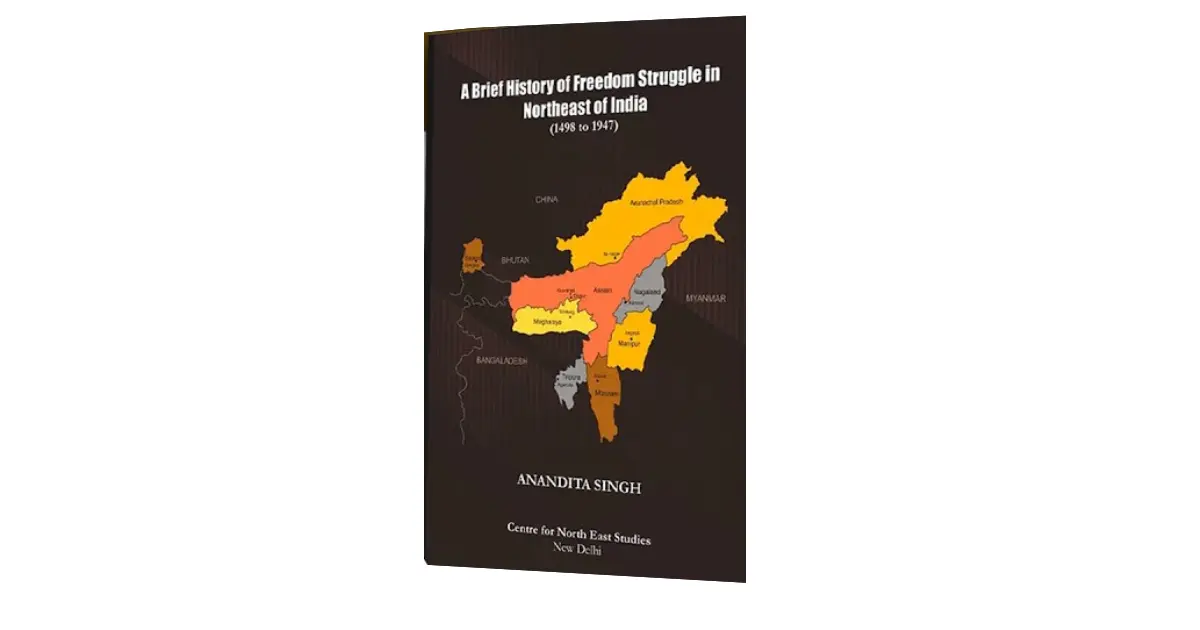
Book Review | A Brief History of Freedom Struggle in NE India
26 October, 2023
968 words
share this article
The struggle for Bhārata’s freedom from European colonisation was undoubtedly bloody and long drawn. Contrary to Marxist perceptions, these battles were not localised, unconcerted and ephemeral; but spread throughout the geography of the land, resisting colonisation since its inception. Though the colonial and post colonial narratives taught in mainstream history have sought to downplay these uprisings as mutinies, that trend has been consistently countered by patriotic historians with evidence. While the tide is yet to turn in the favour of factual history written by indigenous historians, the documentation of revolutionary’s history of certain parts of our country is better known (not yet well known) than certain other parts. Especially, the heroic history of Northeast has not been brought to the fore as vigorously as it should be, leading to discontent from large sections of our society and sometimes even alienation among the Northeastern citizens of our country. This is where scholar Anandita Singh’s work, ‘A Brief History of Freedom Struggle in Northeast of India’, comes in.
The book records the various resistance movements in the Northeast, from the time of East India Company’s exploitation to the crown rule’s despotism up till independence. Unapologetically blunt and diligent, the author minces no words in exposing the duplicity and treachery of the coloniser as demonstrated through his various conquests, identifying the root cause as greed facilitated by theology. She proudly walks in the path of Śrī Sita Ram Goel, Śrī B. B. Kumar and Śrī Dharampal, all three trailblazers who demolished crucial colonial narratives of our history. The cherry on the top is her proclamation of the need of Bhāratīya perspective, something that we at Bṛhat refer to as Svayambodha and Śatrubodha.
Northeast of Bhārata, though it may appear today as a remote location connected precariously with the mainland, was not always so. The united land of Bengal formed a continuum with the Northeast; and with Bengal being the epicentre of colonisers, Northeast too had its early share of looters. However, these advances were repulsed both by the princely states and the local communities.
The role of princely states is generally downplayed in our freedom struggle. Apart from being projected as examples of debauchery and decadence, the kings are also depicted as fighting for their own interests as opposed to the nation’s. Thus the Mutiny of 1857 narrative, as opposed to the War of Independence. Puncturing that narrative through collation of data, this book touches upon the resistance from dynasties such as Ahom, kings of various states like Jaintia, Manipur, Meghalaya, etc., and puts their effort in proper perspective.
The strategic acumen of the British is also apparent for the keen reader who wishes to draw lessons from history. The timing of acquisitions, such as Assam after Burma war, the calibration and recalibration of treaties, replacement of zamindari system with district collectors and in general divide and rule - these all offer serious lessons for us to learn from, in order to avoid a repeat. Even something as unnatural but innocuous as boundaries was employed to annex land slyly.
Evidently, the strategic acumen was accompanied by inhumane ruthlessness as well. The much popularised Jallianwalah Bagh massacre was neither singular nor out of the ordinary. For the Northeast, the author shows how there were multiple massacres by the British forces, where peaceful protestors were mercilessly shot down - such as Phulguri and Pathurghat jansanhārs among others.. The villages where the colonisers suspected that revolutionaries were gaining their support from were burnt down. This was done not by the angst or concern of certain officers, but across the board as a matter of policy.
The saddest story, however, is the story of religious conversion and loss of culture. Whereas once, the fiercely conservative Northeast fought to save its native religion, through the continuous machinations of the coloniser to create a crown colony in the Northeast, today much of it has turned majority Christian. The author depicts the valiant struggle of the Nagas against the British, for example, with Kohima being among the first cities to be liberated by the INA of Subhas Chandra Bose. But today the longest running insurgency in the post independent Bhārata has been the Nagalim for Christ [1] movement. Similarly, other tribal groups such the as Kukis of Manipur, Mishmis of Arunachal, Jaintia of Meghalaya, etc., fought valiantly for swarāj; but many have been turned against the Indian state today through active collaboration of the Church, as can be seen in the recent Manipur crisis[2].
Overall, while being sufficient as a standalone, this book is also an excellent supplement to the recently released book “Revolutionaries: The other story of how India won its freedom” by economist Sanjeev Sanyal, himself the grandnephew of legendary freedom fighter Sachindranath Sanyal.
Each of the battles of the book are topics of further research, and interested people must take up the threads in this book to delve deeper. The book is particularly critical in filling in the vacuum of referential data of the Northeastern revolutionary movement. It makes it abundantly clear that it was a movement where the “Sva” of the people got awakened. It was organic and spontaneous, as has been beautifully shown in the author’s own words:
The freedom struggle was not imported here from the rest of India, it originated here like it did in every awakened speck of dust throughout Bharat.
References:
Raising, Rh. (2023, June 16). Nagas cannot part with issue of “Nagalim for Christ” because everything of Nagas are in it: NSCN-IM - Nagaland Tribune. Nagaland Tribune. https://nagalandtribune.in/nagas-cannot-part-with-issue-of-nagalim-for-christ-because-everything-of-nagas-are-in-it-nscn-im/
Talukdar, S. (2023, October 3). Why Manipur crisis may rank among one of the most misinterpreted tragedies in India. Firstpost; Firstpost. https://www.firstpost.com/opinion/why-manipur-crisis-may-rank-among-one-of-the-most-misinterpreted-tragedies-in-india-13195602.html